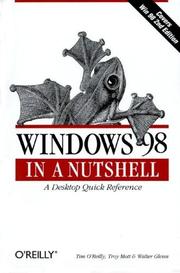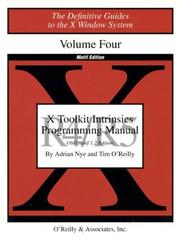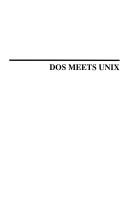| Listing 1 - 10 of 42 | << page >> |
Sort by
|
Book
ISBN: 0937175358 Year: 1990 Publisher: Sebastopol, Calif. O'Reilly
Abstract | Keywords | Export | Availability | Bookmark
 Loading...
Loading...Choose an application
- Reference Manager
- EndNote
- RefWorks (Direct export to RefWorks)
Book
ISBN: 9789045212272 Year: 2017 Publisher: Uithoorn Karakter Uitgevers B.V.
Abstract | Keywords | Export | Availability | Bookmark
 Loading...
Loading...Choose an application
- Reference Manager
- EndNote
- RefWorks (Direct export to RefWorks)
Tim O'Reilly is het geweten van Silicon Valley. Als vooraanstaand denker uit dit centrum van innovatie legt hij uit hoe nieuwe technologieën onze wereld gaan veranderen. Wat hebben zelfrijdende auto's, on demand-dienstverlening, kunstmatige intelligentie en inkomensongelijkheid met elkaar gemeen? Het zijn signalen dat we halsoverkop afstormen op een wereld die door technologie wordt bepaald, op manieren die we niet begrijpen en waarvoor we alle reden hebben bang te zijn. Maar weinigen hebben zo'n vooruitziende blik voor nieuwe technologieën al Tim O'Reilly. In 'De nieuwe economie' onderzoekt hij de dringende vraag hoe wij de technologieën die we creëren de baas kunnen blijven, voordat zij ons de baas worden. Welke keuzes moeten nú gemaakt worden om in de toekomst een wereld te krijgen waarin we willen leven?
Economic order --- Business economics --- Artificial intelligence. Robotics. Simulation. Graphics --- technologie --- management --- communicatie --- communication
Book
ISBN: 9780062565716 Year: 2017 Publisher: New York (N.Y.) : Harper Collins,
Abstract | Keywords | Export | Availability | Bookmark
 Loading...
Loading...Choose an application
- Reference Manager
- EndNote
- RefWorks (Direct export to RefWorks)
Book
ISBN: 9781847941862 Year: 2017 Publisher: London Random House Business Books
Abstract | Keywords | Export | Availability | Bookmark
 Loading...
Loading...Choose an application
- Reference Manager
- EndNote
- RefWorks (Direct export to RefWorks)
Sociology of culture --- Computer architecture. Operating systems --- information technology --- Internet

ISBN: 156592486X Year: 1998 Publisher: Cambridge O'Reilly
Abstract | Keywords | Export | Availability | Bookmark
 Loading...
Loading...Choose an application
- Reference Manager
- EndNote
- RefWorks (Direct export to RefWorks)
Book
ISBN: 0062565729 0062565710 9780062565723 9780062565716 Year: 2017 Publisher: New York, NY : Harper Business,
Abstract | Keywords | Export | Availability | Bookmark
 Loading...
Loading...Choose an application
- Reference Manager
- EndNote
- RefWorks (Direct export to RefWorks)
Silicon Valley's leading intellectual and the founder of O'Reilly Media explores the upside and the potential downsides of our future—what he calls the "next economy." Tim O'Reilly's genius is to identify and explain emerging technologies with world shaking potential—the World Wide Web, Open Source Software, Web 2.0, Open Government data, the Maker Movement, Big Data. "The man who can really can make a whole industry happen," according to Executive Chairman of Google Eric Schmidt, O'Reilly has most recently focused on the future of work—AI, algorithms, and new approaches to business organization that will shape our lives. He has brought together an unlikely coalition of technologists, business leaders, labor advocates, and policy makers to wrestle with these issues. In WTF he shares the evolution of his intellectual development, applying his approach to a number of challenging issues we will face as citizens, employees, business leaders, and a nation. What is the future when an increasing number of jobs can be performed by intelligent machines instead of people, or only done by people in partnership with those machines? What happens to our consumer based societies—to workers and to the companies that depend on their purchasing power? Is income inequality and unemployment an inevitable consequence of technological advancement, or are there paths to a better future? What will happen to business when technology-enabled networks and marketplaces are better at deploying talent than traditional companies? What is the future of education when on-demand learning outperforms traditional institutions? Will the fundamental social safety nets of the developed world survive the transition, and if not, what will replace them? The digital revolution has transformed the world of media, upending centuries-old companies and business models. Now, it is restructuring every business, every job, and every sector of society. Yet the biggest changes are still ahead. To survive, every industry and organization will have to transform itself in multiple ways. O'Reilly explores what the next economy will mean for the world and every aspect of our lives—and what we can do to shape it.
Technological innovations --- Industries --- Employees --- Economic aspects. --- Technological innovations. --- Effect of technological innovations on. --- Social aspects.
Book
ISBN: 1565920147 Year: 1993 Publisher: Sebastopol (Calif.) : O'Reilly,
Abstract | Keywords | Export | Availability | Bookmark
 Loading...
Loading...Choose an application
- Reference Manager
- EndNote
- RefWorks (Direct export to RefWorks)

ISBN: 1565920031 9781565920033 Year: 1992 Volume: 4 Publisher: [Place of publication not identified] O'Reilly Media Incorporated
Abstract | Keywords | Export | Availability | Bookmark
 Loading...
Loading...Choose an application
- Reference Manager
- EndNote
- RefWorks (Direct export to RefWorks)
Volume 4 is a complete guide to programming with the X Toolkit Intrinsics, the library of C language routines that facilitates the design of user interfaces with reusable components called widgets. It provides concepts and examples that show how to use the various X Toolkit routines. The first few chapters are devoted to using widgets; the remainder of the book covers the more complex task of writing new widgets. Volume 4 includes: Introduction to the X Window System. Building applications with widgets. Constructing a bitmap editor with widgets. An overview of each widget in the widget set. Basic widget methods./li> Events, translations, and accelerators. Event handlers, timeouts, and work procedures. Resource management and type conversion. Selections and window manager interaction. Geometry management. Menus, gadgets, and cascaded pop-ups. Miscellaneous techniques. Comparison of Athena, OSF/Motif, and AT&T OPEN LOOK widgets. This book is designed to be used with Volume 5, X Toolkit Intrinsics Reference Manual , which provides reference pages for each of the Xt functions, the widget classes defined by Xt, and the Athena widget set.

ISBN: 1565920139 Year: 1992 Publisher: Sebastopol (Calif.) : O'Reilly,
Abstract | Keywords | Export | Availability | Bookmark
 Loading...
Loading...Choose an application
- Reference Manager
- EndNote
- RefWorks (Direct export to RefWorks)

ISBN: 0937175218 Year: 1988 Publisher: Newton, Mass. O'Reilly
Abstract | Keywords | Export | Availability | Bookmark
 Loading...
Loading...Choose an application
- Reference Manager
- EndNote
- RefWorks (Direct export to RefWorks)
DOS (disk operating system) --- Unix --- OS (operating system) --- Computer architecture. Operating systems
| Listing 1 - 10 of 42 | << page >> |
Sort by
|

 Search
Search Feedback
Feedback About UniCat
About UniCat  Help
Help News
News